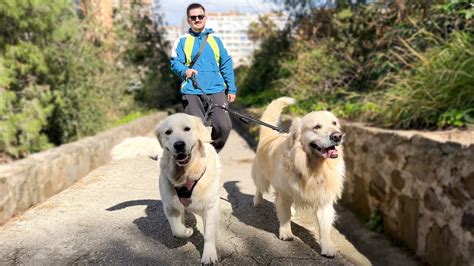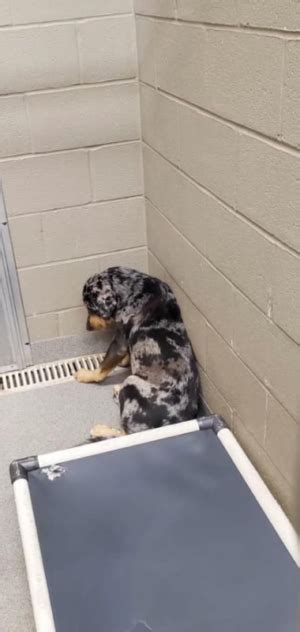
A golden retriever in England decided his walk was over and headed home alone, leaving his owner to catch up.
A golden retriever named Storm, during a recent outing in England, apparently decided his walk with owner, Richard, was complete before Richard did. The canine commuter, opting for an independent journey, reportedly broke away from his owner mid-walk and made his way back to their residence solo. This unusual display of self-sufficiency has garnered attention online, highlighting the dog’s navigational skills and independent spirit.
Richard was walking Storm and his other dog, Barney, in the countryside near their home when Storm decided he was done. According to Richard, nothing unusual happened, and Storm simply peeled off and started walking in the direction of home. “He just decided he’d had enough,” Richard recounted.
The journey home for Storm involved navigating roads and pathways, showcasing an impressive understanding of his environment. The incident raises questions about canine intelligence, independence, and the bond between pets and their owners. While some might find the situation humorous, others might ponder the underlying reasons for Storm’s decision.
The news of Storm’s solo adventure quickly spread across social media platforms, eliciting a range of reactions. Many users expressed amusement and admiration for the dog’s initiative, while others voiced concerns about the potential dangers he might have faced on his unaccompanied journey. The incident serves as a reminder of the unique personalities and behaviors exhibited by our canine companions.
Richard, while initially surprised, was able to track Storm’s progress and eventually met him back at their house. Both dogs were unharmed and the event is now regarded as a humorous anecdote.
Expanded Coverage and Analysis
While the story of Storm’s independent trek is amusing on the surface, it touches upon several deeper aspects related to canine behavior, training, and the relationship between humans and their pets. To fully understand the implications and context of this event, it is crucial to explore the various facets involved.
Understanding Canine Behavior and Independence
Dogs, particularly breeds like golden retrievers, are known for their intelligence and trainability. However, individual dogs exhibit varying degrees of independence and decision-making capabilities. Storm’s decision to head home alone could be attributed to several factors:
- Familiarity with the Route: If Storm had walked the same route numerous times, he would likely have developed a strong mental map of the area, enabling him to navigate back home with confidence.
- Positive Associations with Home: Home represents safety, comfort, and the availability of food and rest for a dog. If Storm was tired or felt the need to return to a familiar environment, his decision to head home becomes more understandable.
- Individual Personality: Some dogs are naturally more independent and adventurous than others. Storm might possess a more self-reliant personality, leading him to take initiative and act on his own.
- Boredom or Discomfort: It’s possible that Storm was bored or uncomfortable during the walk. Perhaps the pace was too slow, the weather was unpleasant, or something along the route caused him distress. While Richard stated that nothing unusual occurred, subtle cues may have been missed.
- Scent Tracking: Dogs have an incredibly keen sense of smell. Storm might have picked up a familiar scent leading back home, prompting him to follow it.
The Role of Training and Socialization
While Storm’s independent journey might seem like a spontaneous act, it is important to consider the role of training and socialization in shaping his behavior. A well-trained dog is more likely to obey commands and stay close to its owner. However, even with proper training, a dog’s natural instincts and personality can sometimes override learned behaviors.
- Recall Training: A strong recall command is essential for ensuring a dog’s safety and preventing situations like Storm’s. If Storm had a rock-solid recall, Richard might have been able to call him back before he ventured off on his own.
- Leash Training: While the article doesn’t specify whether Storm was on or off-leash, leash training plays a crucial role in maintaining control and preventing a dog from wandering off.
- Socialization: Early socialization exposes dogs to various environments, people, and other animals, helping them develop into well-adjusted and confident individuals. A well-socialized dog is less likely to be fearful or anxious, which can contribute to unexpected behaviors.
The Human-Animal Bond and Responsible Pet Ownership
The story of Storm highlights the complex and multifaceted bond between humans and their pets. While we often treat our dogs as members of our families, it is crucial to remember that they are still animals with their own instincts and needs. Responsible pet ownership involves:
- Understanding Canine Behavior: Educating oneself about canine behavior, body language, and communication is essential for building a strong and harmonious relationship with your dog.
- Providing Adequate Exercise and Mental Stimulation: Dogs require regular exercise and mental stimulation to stay healthy and happy. A bored or under-stimulated dog is more likely to exhibit undesirable behaviors.
- Ensuring Safety and Supervision: It is the owner’s responsibility to ensure their dog’s safety and provide adequate supervision, especially in unfamiliar or potentially dangerous environments.
- Being Prepared for the Unexpected: Even with the best training and preparation, unexpected situations can arise. It is important to be vigilant and responsive to your dog’s needs and behaviors.
The Broader Context of Canine Independence
Storm’s solo adventure is not an isolated incident. Stories of dogs exhibiting remarkable independence and navigational skills frequently surface, captivating the public’s imagination. These stories underscore the intelligence and adaptability of canines and their ability to navigate complex environments.
- Service Dogs: Service dogs are trained to perform a wide range of tasks, including navigating public transportation, assisting individuals with disabilities, and providing emotional support. Their ability to perform these tasks independently is a testament to their intelligence and trainability.
- Search and Rescue Dogs: Search and rescue dogs play a vital role in locating missing persons in challenging terrain. They rely on their keen sense of smell and navigational skills to track scents and navigate through dense forests, mountains, and other difficult environments.
- Working Dogs: Working dogs, such as herding dogs and guard dogs, are trained to perform specific tasks independently, often with minimal human supervision. Their ability to make decisions and act autonomously is essential for their effectiveness.
Potential Risks and Concerns
While Storm’s story has a happy ending, it is important to acknowledge the potential risks and concerns associated with dogs wandering off on their own.
- Traffic Accidents: Dogs are vulnerable to traffic accidents, especially in urban or suburban areas with heavy traffic.
- Getting Lost: Dogs can easily become lost, especially in unfamiliar environments.
- Encounters with Other Animals: Dogs may encounter other animals, such as stray dogs or wildlife, which could lead to fights or injuries.
- Theft or Animal Cruelty: Unfortunately, there is always a risk of dogs being stolen or subjected to animal cruelty.
- Exposure to Hazards: Dogs may be exposed to various hazards, such as poisonous plants, contaminated water, or dangerous objects.
Conclusion
The story of Storm, the golden retriever who decided to walk home alone, is a reminder of the unique personalities and behaviors exhibited by our canine companions. While the incident is humorous on the surface, it touches upon deeper aspects related to canine behavior, training, the human-animal bond, and responsible pet ownership. It underscores the importance of understanding canine behavior, providing adequate training and socialization, ensuring safety and supervision, and being prepared for the unexpected. While Storm’s adventure had a positive outcome, it serves as a cautionary tale about the potential risks and concerns associated with dogs wandering off on their own. By understanding these factors, we can foster stronger and more harmonious relationships with our canine companions and ensure their safety and well-being. The incident also highlights the intelligence, adaptability, and independence that dogs can exhibit, reminding us of the remarkable abilities of these beloved animals. The event encourages pet owners to continuously assess their pet’s needs and capabilities while reinforcing safety protocols.
Frequently Asked Questions (FAQ)
-
What breed of dog is Storm?
- Storm is a golden retriever. Golden retrievers are known for their intelligence, friendly nature, and trainability.
-
Where did this incident occur?
- The incident occurred in England, near Storm’s home. The specific location is not mentioned, but the article indicates it was in a countryside area.
-
Was Storm injured during his solo walk home?
- No, Storm was unharmed during his walk home. He arrived safely back at his house.
-
What was the owner’s reaction to Storm’s adventure?
- The owner, Richard, was initially surprised but was able to track Storm’s progress. He met Storm back at their house. The event is now regarded as a humorous anecdote.
-
Why did Storm decide to walk home alone?
- The reasons are not definitively known, but possibilities include familiarity with the route, a desire to return to the comfort of home, individual personality traits, boredom, or following a scent. Richard said that “He just decided he’d had enough.”
-
How far did Storm walk on his own?
- The article does not specify the exact distance that Storm walked on his own.
-
Was Storm on a leash when he decided to head home?
- The article does not mention whether Storm was on or off a leash at the time.
-
Could Storm’s behavior be a sign of a deeper problem?
- While it’s possible, the article suggests it was an isolated incident. However, if a dog frequently displays unexpected or concerning behaviors, it’s advisable to consult with a veterinarian or a certified dog trainer to rule out any underlying medical or behavioral issues.
-
What should owners do if their dog runs away?
- If your dog runs away, immediately begin searching the area, call your dog’s name, and use a whistle or other familiar sound. Contact local animal shelters, post flyers with your dog’s picture, and utilize social media to spread the word. Having your dog microchipped and wearing identification tags can greatly increase the chances of a safe return.
-
How can I prevent my dog from running off?
- To prevent your dog from running off, ensure you have a strong recall command, practice leash training, provide adequate exercise and mental stimulation, and be vigilant about potential hazards in your environment. A secure fence or yard can also help prevent escapes.
-
Is it common for golden retrievers to exhibit this kind of independent behavior?
- While golden retrievers are generally known for their loyalty and trainability, individual dogs can exhibit varying degrees of independence. Storm’s behavior is not necessarily typical, but it is not entirely unheard of either.
-
What are some potential dangers a dog faces when wandering alone?
- Potential dangers include traffic accidents, getting lost, encounters with other animals, theft, animal cruelty, and exposure to hazards such as poisonous plants or contaminated water.
-
Does this incident suggest that the owner is not responsible?
- Not necessarily. While responsible pet ownership involves ensuring a dog’s safety and supervision, even the most diligent owners can encounter unexpected situations. The article presents the incident as a somewhat humorous occurrence, implying that it was an isolated event rather than a pattern of neglect.
-
What are the benefits of microchipping a dog?
- Microchipping provides a permanent form of identification for your dog. If your dog gets lost and is taken to an animal shelter or veterinary clinic, they can scan the microchip and quickly identify you as the owner, increasing the chances of a reunion.
-
What are some tips for improving a dog’s recall ability?
- To improve your dog’s recall ability, start with short distances in a distraction-free environment. Use high-value treats or toys as rewards, and gradually increase the distance and distractions. Always make recall a positive experience, and avoid using it for punishment.
-
How does a dog’s sense of smell contribute to their navigational abilities?
- A dog’s sense of smell is incredibly powerful, allowing them to detect odors from great distances and track scents across complex terrain. They use their sense of smell to create mental maps of their environment and navigate back to familiar locations.
-
What role does a dog’s breed play in its independence and trainability?
- Different breeds have different inherent traits. Some breeds, like golden retrievers, are known for their trainability and desire to please, while others are more independent and require a more experienced handler. Understanding your dog’s breed characteristics can help you tailor your training methods and expectations.
-
How can early socialization impact a dog’s behavior and confidence?
- Early socialization exposes puppies to various environments, people, and other animals, helping them develop into well-adjusted and confident individuals. Proper socialization can reduce fear and anxiety, making dogs less likely to exhibit unexpected or reactive behaviors.
-
What are some signs that a dog is bored or under-stimulated?
- Signs of boredom or under-stimulation in dogs can include excessive barking, chewing, digging, pacing, and attention-seeking behaviors. Providing regular exercise, mental stimulation, and interactive play can help prevent these behaviors.
-
Should dogs always be kept on a leash in public areas?
- Leash laws vary depending on the location. However, it is generally recommended to keep dogs on a leash in public areas to ensure their safety and prevent them from running off or causing problems.
-
What factors should be considered when choosing a walking route for a dog?
- When choosing a walking route, consider factors such as the dog’s fitness level, the weather conditions, the presence of traffic or other hazards, and the availability of shade and water.
-
What are the ethical considerations of allowing a dog to roam freely?
- Allowing a dog to roam freely can pose risks to the dog’s safety and the safety of others. It can also disrupt the local ecosystem and create conflicts with neighbors. Responsible pet owners prioritize the safety and well-being of their dogs and the community.
-
How can technology be used to track a dog’s location?
- GPS trackers can be attached to a dog’s collar to monitor their location in real-time. These trackers can provide valuable information if a dog gets lost or runs away.
-
What is the importance of understanding canine body language?
- Understanding canine body language allows owners to better interpret their dog’s emotions and intentions. Recognizing signs of stress, fear, or aggression can help prevent accidents and ensure the dog’s well-being.
-
How does the legal responsibility for a dog’s actions vary by location?
- Legal responsibilities for a dog’s actions can vary significantly by location. Owners may be held liable for damages or injuries caused by their dogs, depending on local laws and regulations. It’s important to be aware of the specific laws in your area.









